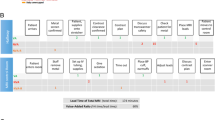Abstract
As physicians continue search for ways to deliver high quality care to their patients and families, newer tools and methods are being introduced. Initially developed by manufacturing, quality improvement methods have been slowly adopted by healthcare and are now standard curriculum in medical schools. The IHI Model for Improvement allows for teams to create. model for change, test proposed changes in clinical situations, measure the results and then accept or modify the proposed changes. Additional tools such as process maps, Pareto charts, Ishikawa diagrams, and key driver diagrams provide structure and visual representation to the team during the creation and implementation of. quality improvement initiative. As participation in quality improvement is becoming an expectation for all health care providers, familiarity with these tools will assist teams with implementing improved processes in their local systems of care.
This is a preview of subscription content, access via your institution
Access options
Subscribe to this journal
Receive 12 print issues and online access
$259.00 per year
only $21.58 per issue
Buy this article
- Purchase on Springer Link
- Instant access to full article PDF
Prices may be subject to local taxes which are calculated during checkout





Similar content being viewed by others
References
Swanson J, Pearlman S. Roadmap to. successful quality improvement project.. Perinatol. 2017;37:112–5.
Lachman P, Jayadev A, Rahi M. The case for quality improvement in the neonatal intensive care unit. Early Hum Dev. 2014;90:719–23.
Langley GJ, Nolan KM, Nolan TW. The foundation of improvement. Silver Spring, MD: API Publishing; 1992.
Doran GT. There’s. S.M.A.R.T. way to write management’s goals and objectives. Management Review. AMA FORUM. 1981;70:35–36.
Langley GL, Moen R, Nolan KM, Nolan TW, Norman CL, Provost LP. The improvement guide:. practical approach to enhancing organizational performance. 2nd ed. San Francisco: Jossey-Bass Publishers; 2009.
Agency for healthcare research and quality practice facilitation handbook. Health literacy universal precautions toolkit, 2nd ed. Plan-Do-Study-Act (PDSA) directions and examples. https://www.ahrq.gov/professionals/quality-patient-safety/quality-resources/tools/literacy-toolkit/healthlittoolkit2-tool2b.html Accessed 30 Oct 2017.
Gillam S, Siriwardena AN. Frameworks for improvement: clinical audit, the plan-do-study-act cycle and significant event audit. Qual Prim Care. 2013;21:123–30.
Dias S, Saraiva PM. Use basic quality tools to manage your processes. Qual Progress. 2004;37:47–53.
Trebble TM, Hansi N, Hydes T, Smith MA, Baker M. Process mapping the patient journey: an introduction. BMJ. 2010;341:c4078.
Joosten T, Bongers I, Janssen R. Application of lean thinking to health care: issues and observations. Int. Qual Health Care. 2009;21:341–7.
Juran JM, Godfrey AB. Juran’s quality handbook. 5th ed. New York City: McGraw-Hill; 1998.
Wilkinson L. Revising the Pareto Chart, The American Statistician. 2012;60:332-334, https://doi.org/10.1198/000313006X152243.
American Society for Quality. Cause analysis tools: pareto chart. 2009. http://www.asq.org/learn-about-quality/cause-analysis-tools/overview/pareto.html Accessed. Sept. 2017.
Tague NR. Seven Basic Quality Tools. In: The Quality Toolbox. Milwaukee, Wisconsin: American Society for Quality; 2004. p. 15.
Provost L, Bennett B. What’s your theory? Driver diagram serves as tool for building and testing theories for improvement. Qual Prog. 2015;48:36–43.
Author information
Authors and Affiliations
Corresponding author
Ethics declarations
Conflict of interest
The authors declare that they have no conflict of interest.
Rights and permissions
About this article
Cite this article
Picarillo, A.P. Introduction to quality improvement tools for the clinician. J Perinatol 38, 929–935 (2018). https://doi.org/10.1038/s41372-018-0100-4
Received:
Revised:
Accepted:
Published:
Issue Date:
DOI: https://doi.org/10.1038/s41372-018-0100-4
This article is cited by
-
Quality improvement in the golden hour for premature infants: a scoping review
BMC Pediatrics (2024)
-
Multidimensional assessment of infant, parent and staff outcomes during a family centered care enhancement project in a tertiary neonatal intensive care unit: study protocol of a longitudinal cohort study
BMC Pediatrics (2023)
-
Organizing and Leading a Multidisciplinary PICU
Indian Journal of Pediatrics (2023)
-
Advancements in neonatology through quality improvement
Journal of Perinatology (2022)
-
Supplementation-based hypoglycemia guidelines including donor breast milk reduce NICU admission
Journal of Perinatology (2021)



